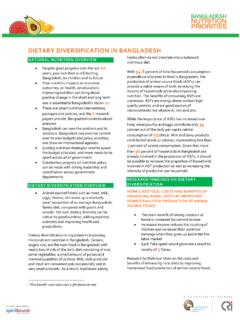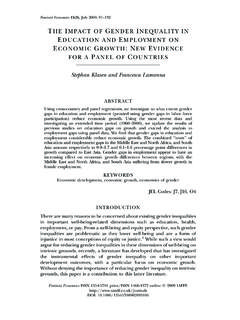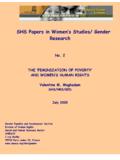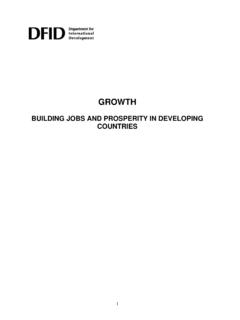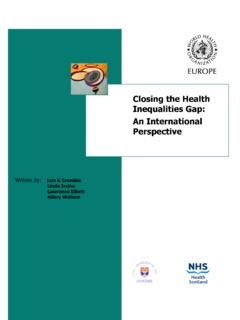Transcription of assessment paper GENDER INEQUALITY
1 assessment paper GENDER INEQUALITY . Joyce P. Jacobsen GENDER INEQUALITY A Key Global Challenge: Reducing Losses due to GENDER INEQUALITY Joyce P. Jacobsen Wesleyan University Middletown CT USA. assessment paper Copenhagen Consensus on Human Challenges 2011. Abstract This assessment considers the worldwide costs from 1900 to 2050 of continued GENDER INEQUALITY . The main cost is considered to be the inefficient underutilization of women in production. This can be measured in terms of their correspondingly lower earnings and expressed as a percentage of actual GDP per annum. This loss is estimated to lie in the range of 4 percent to 37 percent of world GDP per annum over this time period, depending on the year and the assumptions made.
2 The losses due to GENDER INEQUALITY are declining as a percentage of GDP over this time period, but the absolute sizes of the losses are still quite substantial, since world GDP is growing so substantially over this period. This can be seen in part by comparing the losses in terms of 1900 GDP: In 2050, which has the lowest potential losses (4 percent) as a percentage of GDP based on the lower loss projections, the loss attributable to GENDER INEQUALITY comprises 328 to 1019 percent of total world GDP as of 1900, which is a range of $6 to $20 trillion in 1900 dollars, well over what world output was worth in 1900.
3 Introduction to the challenge GENDER INEQUALITY pervades the world. In considering the dimensions of economic GENDER INEQUALITY , women still make less than men in the formal work sector, are more likely to live in poverty, are less likely to participate in the formal work sector, and do a larger share of work in the household sector. The dimensions of political GENDER INEQUALITY include women's lower representation in elected office and lower representation in political and corporate appointments. Social GENDER INEQUALITY has numerous dimensions, some of which are less favorable to men while others are less favorable to women: men are more prone to violence, imprisonment, and disability, while women are more likely to be the victims of domestic violence and sexual assault; in some countries men have lower educational attainment than women, while the pattern is reversed in other countries.
4 Demographic GENDER INEQUALITY includes the fact that men live shorter lives on average than do women (65 years for men, 69 years for women CIA 2010), but there is also concern that many women are never given the chance to be born, and in the younger generations men now outnumber women, by large numbers in China and India in particular (with GENDER ratios respectively of 113 men and and 117 men per hundred women in the under-15 age range CIA 2010). While many of the costs of GENDER INEQUALITY are ultimately born by particular individuals, they can also be calculated at a society, or even worldwide level.
5 If individuals of different genders are not given equal opportunity to develop their potential, then societies forego the increased level of output and ultimately wellbeing that would derive from their higher productivity. If societies do not invest equally in educating and training men and women, do not give them equal opportunities to engage in more productive forms of work, and do not give them equal opportunities to advance to more productive positions over time, then the societies do not harness the full potential of their members. The goal of this chapter is to perform such a calculation, in which the costs to human society of GENDER INEQUALITY , measured as a percent of actual GDP worldwide and for subregions, are calculated for the years 1900 through 2050.
6 These numbers can also be used to measure the total cumulative costs over the past 110. years of GENDER INEQUALITY and to project forward the expected additional costs over the next forty years. Background to the challenge While many readers are likely familiar with the main dimensions of GENDER INEQUALITY , this section provides a quick overview of the empirical patterns researchers have documented, particularly over the course of the twentieth century. The nineteenth century saw the rise of the women's suffrage movement across western countries and a general push for equal treatment of women and men under the law.
7 In 1893 New Zealand became the first country to extend the right to vote to women; most countries followed suit in the first part of the twentieth century ( , Denmark in 1915, the in 1920), while other countries were much later (Liechtenstein in 1984;. Kuwait in 2005). 1. Many other forms of legal discrimination against women persisted beyond suffrage, however. It was only in 1963 that the US passed the Equal Pay Act, making it illegal to pay women and men different wages for equal work; it took a while for other countries to follow suit ( , Ireland in 1976; Japan in 1987). Not surprisingly, women's participation in paid work was fairly limited before the latter half of the twentieth century.
8 As an example, Figure 1 shows the growth for the US in women's labor force participation (as compared to men's more static and eventually declining participation). from 1800 up until the present. Participation rises steadily throughout, but at an accelerated rate after1940, with a recent downturn in participation since 2000. Women as a percentage of the labor force has leveled out at around 46 percent. Figure 1. US labor force participation rates by sex and percentage of labor force that is female, 1800 to 2010. 90. 80. male labor force 70 participation rate 60. female labor force 50 participation rate 40 percentage female in labor force 30.
9 20. 10. 0. 1800 1820 1840 1860 1880 1900 1920 1940 1960 1980 2000. notes: Sources: 1800-1860 - Thomas Weiss, ``Revised Estimates of the United States Workforce, 1800-1860,''. Long-Term Factors in American Economic Growth, eds. Stanley L. Engerman and Robert E. Gallman (Chicago, Ill.: University of Chicago, 1986): 657 (Table ), 658-659 (Table ); 1870-1940 - Bureau of the Census, Historical Statistics of the United States (Washington, : Government Printing Office, 1976): Series D13.; 1950-70 - Bureau of the Census, Historical Statistics of the United States (Washington, : Government Printing Office, 1976): Series D13; 1980-2005 - Economic Report of the President 2011: 234 (Table B-36), 237 (Table B-39).
10 Data for 1800-60 are for free persons only. Data for 1800-1930 are for persons ages 10. and over, for 1940 are for persons ages 14 and over, for 1950-60 are for persons ages 14 and over, for 1970- 2010 are for persons ages 16 and over. 2. Table 1 shows comparable contemporary data to Figure 1 for sets of countries sorted by per capita income level. It is notable that there is still a wide range of participation rates found in present-day so that countries have not converged on a specific higher level of female participation in paid work. Interestingly, there is a convex shape with regards to women's participation, with lower participation rates for the middle income countries compared to both the low and high income countries.

